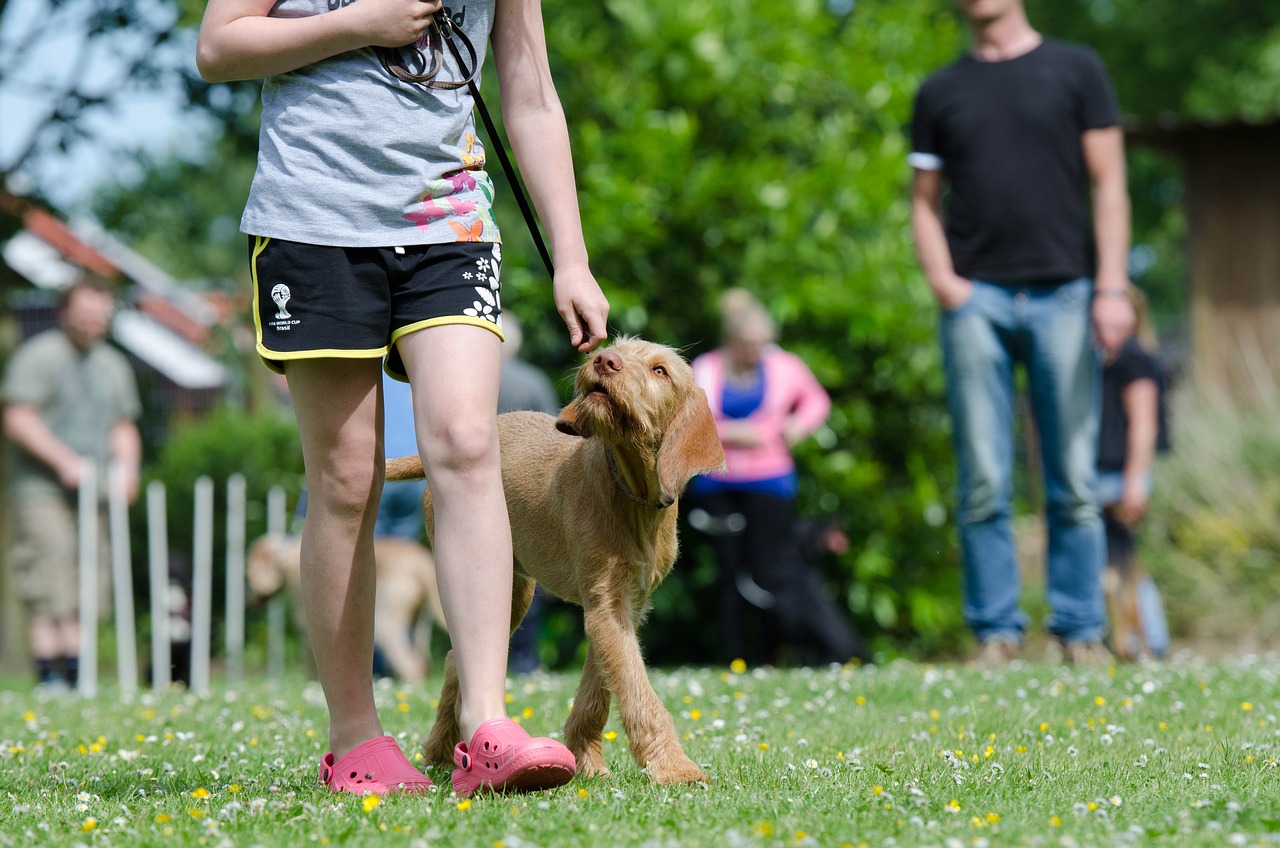Tips for Training Your Dog to Use a Bell to Go Outside
Have you ever wished your dog could just let you know when they need to go outside? Well, you're in luck! Training your furry friend to use a bell as a signal for outdoor access is not only a fun bonding experience but also a practical solution to enhance communication between you and your pet. Imagine your dog ringing a bell to let you know it’s time for a potty break instead of scratching at the door or barking incessantly. This method can lead to a happier, more relaxed home environment for both of you!
Before diving into the training process, it’s essential to grasp the fundamentals of bell training. Using a bell for potty training can significantly improve your dog's ability to communicate their needs. Not only does this method encourage your dog to express themselves, but it also helps you avoid potential accidents in the house. Think of it as giving your dog a voice! The benefits extend beyond just potty training; it can also enhance your dog's overall behavior and obedience. When dogs feel understood, they tend to be more confident and well-adjusted.
Now that you understand the basics, let’s talk about selecting the right bell for your training needs. The type of bell you choose can make a world of difference in how effective the training will be. There are various options available, each with its unique features and benefits. The right bell should cater to your dog's size, personality, and preferences. A bell that’s too loud might scare a timid dog, while one that’s too soft may not get your attention. It’s all about finding that perfect balance!
When it comes to dog training bells, you have several choices. Here are a few popular options:
- Traditional Bells: Simple and effective, these are often easy to find and use.
- Electronic Bells: These bells come with features like sound customization and can be activated with a paw or nose.
- DIY Solutions: For the crafty pet parent, creating your own bell setup can be a rewarding experience.
Traditional bells are a classic choice for dog training. They are usually made of metal and come in various sizes. Their advantages include ease of use and availability at most pet stores. Plus, they provide a satisfying sound that your dog can easily learn to associate with going outside. If you’re looking for something straightforward, a traditional bell might be the way to go!
If you want to step up your game, electronic bells offer additional features that can enhance the training experience. Some electronic bells allow you to customize the sound, which can be particularly useful if you have multiple pets. However, they can be a bit more complex and may require batteries. Weigh the pros and cons to see if this option fits your training style!
For those who love a hands-on approach, creating a DIY bell setup can be incredibly fulfilling. Not only can it be a fun project, but it also allows you to tailor the bell to your dog’s preferences. You can use materials like rope and small bells to create a system that hangs near your door. Here’s a simple way to get started:
1. Gather materials: bells, rope, and a sturdy hook. 2. Cut the rope to your desired length. 3. Attach the bells securely to one end of the rope. 4. Hang the hook near your door at your dog’s height. 5. Introduce your dog to the bell!
Training your dog to use a bell requires patience and consistency. Start by introducing the bell in a positive way. Allow your dog to sniff and interact with it. You can even encourage them to paw or nudge it with their nose. Always reward them with praise or treats when they engage with the bell. This positive reinforcement will help them associate the bell with going outside. Over time, they will learn to ring the bell whenever they need to go out!
The initial introduction of the bell is critical. Make it a fun experience! Allow your dog to explore the bell at their own pace. You can even play a little game where you ring the bell and then take them outside. This will help them understand that the bell is the key to their outdoor adventure.
Once your dog starts to show interest in the bell, it’s time to reinforce that behavior. Every time they ring the bell, immediately take them outside. Be consistent with your response, and soon they will associate ringing the bell with going out to relieve themselves. Remember, it’s all about making the experience positive for your dog!
Like any training process, bell training may come with its challenges. One common issue is that some dogs may be hesitant to use the bell at first. If you notice your dog is reluctant, don’t worry! There are strategies to encourage them. For instance, you can try placing treats near the bell to spark their curiosity.
To help a reluctant dog, try to make the bell a part of their playtime. Engage them with the bell by playing games that involve ringing it. This can help build their confidence and increase their willingness to use it when they need to go outside.
Maintaining consistency is vital for successful training. Establish a routine that reinforces bell usage. For example, always take your dog outside after they ring the bell, and try to practice this several times a day. With regular practice, your dog will learn that the bell is their ticket to outdoor fun!
1. How long does it take to train my dog to use the bell?
The time it takes can vary based on your dog’s personality and your training consistency. Some dogs may learn within a few days, while others may take weeks. Patience is key!
2. What if my dog doesn’t seem interested in the bell?
Try using treats or toys to create a positive association with the bell. You can also engage them in play that involves the bell to spark their interest.
3. Can I use any type of bell?
Yes, but it's best to choose a bell that is easy for your dog to reach and activate. Consider their size and strength when selecting a bell.
With these tips and techniques, you’ll be well on your way to successfully training your dog to use a bell for outdoor access. Happy training!

Understanding the Basics of Bell Training
Before diving into the exciting world of bell training, it's essential to grasp the fundamentals that make this method effective. Bell training is not just a quirky trend; it’s a practical way to enhance communication between you and your furry friend. Imagine your dog having the ability to tell you when they need to go outside, just like a toddler tugging at your shirt to get your attention. This method not only fosters better understanding but also significantly improves potty training success.
So, why should you consider using a bell? Here are some compelling reasons:
- Clear Communication: A bell provides a clear signal that your dog needs to go out, reducing the chances of accidents indoors.
- Empowerment: Teaching your dog to use a bell empowers them to communicate their needs, making them feel more in control.
- Fun and Engaging: The training process can be a fun bonding experience for both you and your pet, creating lasting memories.
Moreover, bell training can be particularly beneficial for puppies. They often lack the ability to vocalize their needs effectively, and a bell serves as a perfect tool for them to express themselves. Think of it as giving your puppy a voice, allowing them to let you know when they need to go out without the stress of accidents in the house.
However, it’s important to remember that like any training method, bell training requires patience and consistency. Dogs thrive on routine, and establishing a regular practice will help them understand the connection between ringing the bell and going outside. It’s not just about teaching them to ring a bell; it’s about building a reliable communication system that benefits both of you.
In summary, bell training is a fantastic way to bridge the communication gap between you and your dog. By understanding the basics, you set the stage for a successful training experience that enhances your dog's ability to express their needs, ultimately leading to a happier and healthier pet.

Choosing the Right Bell
When it comes to training your dog to use a bell to signal their need to go outside, is a crucial step that can significantly impact the success of your training efforts. With a variety of options available on the market, it's essential to consider factors such as your dog's size, temperament, and personal preferences. A well-chosen bell not only enhances communication between you and your furry friend but also makes the training process more enjoyable for both parties.
First and foremost, think about the size of the bell. If you have a small dog, a smaller, lighter bell may be more suitable, as it will be easier for them to nudge with their nose or paw. Conversely, larger breeds may require a more robust bell that can withstand their strength. Additionally, consider the volume of the bell. You want a sound that is loud enough to be heard throughout your home, but not so jarring that it scares your pet.
Next, let's talk about the material of the bell. Bells come in various materials, from metal to plastic. Metal bells tend to produce a clearer and more resonant sound, which can be beneficial for training. However, if your dog has a tendency to chew or play rough, a durable plastic bell might be a better choice to prevent breakage. It's all about finding the right balance between functionality and safety.
Here’s a quick overview of some common types of bells:
- Traditional Bells: Simple, effective, and widely available, these bells are often made of metal and come in various sizes.
- Electronic Bells: These bells may offer features like customizable sounds or lights, which can be fun but may require batteries.
- DIY Solutions: For the crafty pet owner, creating a personalized bell setup can be a rewarding project that adds a personal touch to your training.
Finally, think about the location where you will place the bell. It should be easily accessible to your dog, allowing them to reach it without any hassle. Many dog owners choose to hang the bell by the door or attach it to a nearby wall or furniture. This way, your dog can easily tap the bell when they want to go outside, creating a clear and consistent signal for both of you.
In conclusion, the right bell can make a world of difference in your dog's training journey. By considering factors like size, material, and placement, you can select a bell that not only meets your dog's needs but also enhances your communication and strengthens your bond. Remember, the goal is to create a positive experience for your dog, so take your time in choosing the perfect bell that suits their personality and your lifestyle.
1. How do I know if my dog is ready to start bell training?
Most dogs can begin bell training as soon as they understand basic commands and have established a routine for going outside. Look for signs that your dog is ready to communicate their needs, such as pacing by the door or whining.
2. Can I use any type of bell for training?
Yes, you can use various types of bells for training. Just ensure that the bell is easily accessible and produces a sound that can be heard throughout your home.
3. What if my dog is scared of the bell?
If your dog shows fear towards the bell, take a step back and allow them to get used to it gradually. Start by letting them sniff and explore the bell before introducing it into your training routine.
4. How long does it take to train my dog to use the bell?
The time it takes to train your dog to use the bell can vary based on the individual dog and the consistency of your training. Some dogs may catch on quickly, while others may take a few weeks to fully understand.
Types of Bells
When it comes to training your furry friend to use a bell to signal their need to go outside, the type of bell you choose can significantly impact the success of your training efforts. There are several options available, each with its unique features and benefits. Understanding these types can help you make an informed decision that suits both your dog's needs and your training style.
First up, we have traditional bells. These are the classic options that many dog owners gravitate towards. Traditional bells are typically simple, hand-held bells that can be hung near your door. They are easy to use and require no batteries or complicated setups. Just a gentle tap from your pup's nose or paw is enough to make a delightful sound, alerting you that it's time to head outside. Many dog owners appreciate the straightforwardness of traditional bells, as they are widely available and often come in various sizes and designs.
Next, let’s talk about electronic bells. These modern alternatives offer some exciting features that traditional bells do not. For instance, electronic bells can be programmed to emit different sounds, which can be particularly appealing if you want a unique signal. Some models even come with lights or other sensory feedback that can help your dog associate the bell with going outside. However, they may require batteries and a bit more setup, which can be a downside for some. It's essential to weigh the pros and cons, as electronic bells can sometimes be more expensive than their traditional counterparts.
Lastly, for those who enjoy a bit of creativity, DIY bell solutions can be a fun and rewarding project. You can easily make your own bell system with materials you have at home. For example, you can use a small hand bell or even a string of jingle bells attached to a door handle. This approach allows you to customize the bell to your liking and can be an excellent way to bond with your dog during the training process. Plus, it often costs less than buying a pre-made option.
In summary, the type of bell you choose can play a crucial role in your dog's training experience. Whether you opt for traditional bells, electronic options, or a DIY project, each type has its advantages and can be effective in teaching your dog to communicate their need to go outside. Just remember that the key is to find a bell that resonates with both you and your furry friend, making the training process enjoyable and successful.
Traditional Bells
When it comes to training your dog to use a bell for outdoor access, are often the go-to choice for many pet owners. These bells are typically simple in design and function, making them incredibly user-friendly. You might be wondering, what exactly makes traditional bells so appealing? Well, for starters, they are readily available at most pet supply stores or even online, meaning you can easily get your hands on one without any hassle. Plus, they don’t require batteries or complicated setups, making them an excellent choice for those who prefer straightforward solutions.
One of the significant advantages of traditional bells is their audibility. The sound they produce is usually loud enough to be heard throughout your home, ensuring that you won't miss your dog's signal to go outside. This is particularly beneficial during those moments when you might be distracted or busy with other tasks. In contrast to electronic options, traditional bells offer a consistent sound that your dog can learn to associate with bathroom breaks. This association is crucial for effective training.
Additionally, traditional bells can be easily customized to fit your dog's needs. For instance, you can choose from various sizes and styles, ensuring that you find a bell that your dog will feel comfortable using. Some pet owners even opt to decorate their bells with colorful ribbons or personal touches, making the training process a bit more fun and engaging. But remember, the key is to ensure that the bell is accessible for your dog. Hang it at a height they can reach easily, whether that’s at the door or a nearby wall, so they can signal you without any struggle.
However, while traditional bells are indeed effective, they do come with a few considerations. For example, if you have a particularly energetic dog, you may find that they might accidentally knock the bell off its hook during playtime. To prevent this, consider using durable materials for the bell or securing it in a way that it remains stable. Ultimately, traditional bells serve as a reliable, cost-effective, and straightforward solution for teaching your dog to communicate their need to go outside.
Electronic Bells
When it comes to training your dog to use a bell for outdoor access, can offer some exciting features that traditional bells simply can't match. These high-tech devices often come with customizable sounds, volume adjustments, and even wireless capabilities, making them a popular choice for tech-savvy pet owners. Imagine your furry friend signaling their need to go outside with a cheerful chime that you can tailor to your liking! However, while the allure of gadgets can be tempting, it's essential to weigh the pros and cons before making a decision.
One of the standout benefits of electronic bells is their ability to provide a consistent auditory cue. Unlike traditional bells that may sound different every time, electronic options can deliver the same sound repeatedly, helping your dog to associate that specific sound with the action of going outside. This consistency can be particularly helpful for puppies or dogs who are easily distracted. Also, many electronic bells allow you to adjust the volume, which means you can set it to a level that suits both your dog's sensitivity and your home environment.
However, there are a few potential drawbacks to consider. For instance, electronic bells require batteries or charging, which can be an inconvenience. Additionally, some dogs may be startled by the sound or the mechanism of the bell, especially if they're not used to technology. This is where patience and gradual introduction come into play. You might need to spend some time getting your dog comfortable with the bell before expecting them to use it effectively.
Here’s a quick comparison of traditional versus electronic bells:
| Feature | Traditional Bells | Electronic Bells |
|---|---|---|
| Sound Customization | No | Yes |
| Volume Control | No | Yes |
| Power Source | None | Batteries/Rechargeable |
| Ease of Use | Very Easy | Moderate |
| Price | Generally Lower | Generally Higher |
In summary, electronic bells can be a fantastic addition to your dog training toolkit, offering unique features that can enhance communication between you and your pet. Just remember, whether you choose a traditional or electronic bell, the key to success lies in consistent training and positive reinforcement. So, as you embark on this journey, keep your dog's comfort and preferences in mind, and you'll be well on your way to a well-trained pup!
DIY Bell Solutions
If you're the crafty type, creating a DIY bell solution for your dog can be a fun and rewarding project. Not only does it allow you to customize the bell to your dog's preferences, but it also saves you some bucks! Plus, it can be a great bonding experience as you involve your furry friend in the process. So, let’s roll up our sleeves and dive into how to make a simple yet effective bell setup.
To get started, you’ll need a few materials, which are easily found around your home or at a local craft store. Here’s a quick list of what you’ll need:
- A sturdy bell – This can be a traditional jingle bell or a larger, louder bell depending on your dog’s size and hearing ability.
- A piece of rope or ribbon – This will be used to hang the bell at your dog’s height, making it easy for them to reach.
- A hook or adhesive strip – To attach the bell to the door frame or wall.
- Optional decorations – If you want to add a personal touch, consider using paint or stickers to customize the bell.
Once you have your materials, the process is straightforward:
- Prepare the Bell: If you’re using a traditional bell, ensure it’s clean and free of any debris. If you’ve chosen a decorative bell, let your creativity shine by painting or adding stickers.
- Attach the Rope: Tie a sturdy knot around the bell with your rope or ribbon. Make sure it’s secure enough that your dog won’t accidentally pull it off.
- Hang the Bell: Use a hook or adhesive strip to position the bell at your dog’s nose level. This makes it easy for them to reach and use it when they need to go outside.
- Test It Out: Once everything is set up, give it a test run. Encourage your dog to interact with the bell by ringing it yourself and rewarding them with treats when they show interest.
By using this DIY bell solution, you not only create a functional tool for your dog's potty training but also add a personal touch that can make the experience more enjoyable for both of you. Remember, the key to success is consistency and positive reinforcement. So, make sure to celebrate every little victory along the way!
Q: What type of bell is best for DIY solutions?
A: A traditional jingle bell is often the easiest to work with, but any bell that produces a clear sound will do. Just ensure it’s not too heavy for your dog to ring.
Q: How do I encourage my dog to use the bell?
A: Start by ringing the bell yourself and rewarding your dog when they show interest. Gradually, guide them to ring it before going outside, rewarding them each time they do.
Q: Can I use a different signaling method instead of a bell?
A: Absolutely! Some dog owners use a tapping sound or even a specific word. The important part is to be consistent so your dog learns to associate it with going outside.

Steps to Train Your Dog
Training your dog to use a bell is a rewarding experience that can greatly enhance communication between you and your furry friend. The process requires patience, consistency, and a sprinkle of creativity. So, roll up your sleeves and get ready to embark on this exciting journey! The first crucial step is to introduce the bell to your dog. Start by allowing them to sniff and explore the bell, creating a positive association. This can be done during playtime or when they are in a relaxed state. You might even want to use treats to encourage them to interact with the bell. For instance, hold a treat near the bell and let them nudge it to get the reward. This initial interaction is essential as it lays the groundwork for the training to come.
Once your dog is comfortable with the bell, it’s time to reinforce the behavior. This is where the magic happens! Every time your dog interacts with the bell, whether by nudging it or pawing at it, reward them immediately with praise or a treat. This positive reinforcement helps them associate the bell with good things, making them more likely to use it again. Remember, consistency is key. Make sure to reward them every single time they use the bell, especially in the beginning. Over time, they will begin to understand that ringing the bell equals going outside.
As you progress, it’s important to establish a routine. Dogs thrive on routine, and setting specific times for potty breaks can help reinforce bell usage. For example, consider taking your dog outside after meals, playtime, or when they wake up. This creates a predictable pattern that your dog can learn to anticipate. You might even want to keep a training log to track your dog’s progress. This can include notes on when they use the bell, how often they go outside, and any challenges you encounter. Keeping a record can help you identify patterns and adjust your training methods if needed.
However, training isn’t always a walk in the park. Some dogs may be hesitant to use the bell initially. If you notice your pup is reluctant, don’t fret! Instead, try to make the bell more enticing. You can do this by incorporating it into their favorite games. For example, play a game of fetch with the bell or hide it and encourage them to find it. This playful approach can help build their confidence and make them more willing to engage with the bell.
Finally, remember that patience is your best friend during this training process. Every dog learns at their own pace, and it’s essential to celebrate small victories along the way. If your dog successfully uses the bell, throw a mini celebration! This could be a fun play session or an extra treat. The goal is to create a positive and enjoyable experience that encourages them to keep using the bell.
Q: How long does it take to train my dog to use the bell?
A: The time it takes can vary greatly depending on your dog's personality and previous training experiences. Some dogs may grasp the concept within a few days, while others may take weeks. Consistency and positive reinforcement are key!
Q: What if my dog ignores the bell?
A: If your dog seems uninterested, try making the bell more appealing. Use treats or toys to encourage interaction. You can also try different types of bells to see if one captures their interest more than others.
Q: Can I train an older dog to use the bell?
A: Absolutely! Dogs of all ages can learn new tricks. Older dogs may take a bit longer to adjust, but with patience and consistent training, they can successfully learn to use the bell.
Introducing the Bell
Introducing the bell to your dog is a crucial step in the training process. Think of it as a first date; you want to make a great impression and create a positive experience that leaves them wanting more. Start by selecting a quiet environment free from distractions. This will allow your dog to focus on the bell and the training process. You can use a traditional bell, an electronic one, or even a DIY solution that you’ve crafted. The key is to ensure it’s something your dog can easily access and interact with.
Begin the introduction by allowing your dog to sniff and explore the bell. Dogs are naturally curious creatures, and this exploration phase is essential. You can encourage them by gently tapping the bell yourself, making a cheerful sound, or using a playful tone to pique their interest. It’s like inviting them to join a fun game! Once your dog shows interest, reward them with a treat or praise. Positive reinforcement at this stage is vital; it helps create a positive association with the bell. You want your dog to think, “Wow, this bell is awesome!”
As your dog becomes more comfortable with the bell, you can start to incorporate it into your routine. For instance, each time you take them outside, guide their paw or nose to touch the bell. This action should be paired with a verbal cue, such as “Bell!” or “Outside!” Consistency is key here. By repeating this process, your dog will start to understand that ringing the bell means it’s time to go outside. It’s like teaching them a secret handshake that opens the door to their favorite outdoor adventures!
Remember, patience is essential during this phase. Some dogs may take longer than others to warm up to the bell. If your dog seems hesitant or uninterested, don’t force the interaction. Instead, try to make it a fun and engaging experience. You might even consider using toys or treats to encourage them to play with the bell. The goal is to create a positive and enjoyable association that makes them eager to use it in the future.
In summary, introducing the bell is about creating a fun, positive experience for your dog. By encouraging exploration, using positive reinforcement, and incorporating the bell into your routine, you’re setting the stage for successful bell training. After all, who wouldn’t want to communicate their needs in such a fun way? So, let’s get that bell ringing!
Reinforcing the Behavior
Once your dog starts to interact with the bell, it's crucial to reinforce this behavior to ensure they associate the bell with going outside. Positive reinforcement is the golden rule of dog training; it’s like giving your furry friend a high-five every time they do something right! When your dog rings the bell, immediately take them outside. This quick response helps them make the connection between the action of ringing the bell and the reward of going outside.
Now, how do you effectively reinforce this behavior? Start by using treats or their favorite toy as a reward. When your dog successfully rings the bell, shower them with praise and give them a treat right away. This immediate reinforcement creates a positive experience and encourages them to repeat the action. Remember, timing is everything! If you wait too long to reward them, they might not understand what they are being praised for.
Additionally, consistency is key. Make sure that every time your dog rings the bell, they are rewarded in the same manner. This could mean using the same treat or offering the same level of enthusiasm in your praise. Over time, your dog will learn that ringing the bell leads to a fun outing and maybe even a tasty snack! Just like how we humans love a good reward for our efforts, dogs thrive on the same principle.
As you continue this process, gradually reduce the frequency of treats while maintaining the praise. This way, your dog will still feel encouraged without becoming dependent on treats every time. You can think of it as transitioning from a training wheels phase to a more independent riding phase. Eventually, your dog will learn to ring the bell simply because they know it leads to a fun adventure outside.
To summarize, when reinforcing the behavior of using the bell, keep the following points in mind:
- Immediate Rewards: Always reward right after the bell is rung.
- Use Consistent Rewards: Stick to the same treats or praise style.
- Gradual Reduction: Slowly decrease treat frequency while maintaining praise.
By following these guidelines, you'll create a clear and enjoyable learning experience for your dog. Remember, training should be fun for both you and your furry companion. So, keep it light-hearted, and don’t forget to celebrate those little victories along the way!
Q: How long does it take for my dog to learn to use the bell?
A: The time it takes can vary greatly depending on the dog. Some may catch on within a few days, while others might take a few weeks. Patience and consistency are key!
Q: What if my dog is afraid of the bell?
A: If your dog shows fear, try introducing the bell in a calm environment. Allow them to sniff it and get familiar with it before expecting them to use it. Positive reinforcement can help alleviate their fear.
Q: Can I use other signals instead of a bell?
A: Absolutely! While a bell is a popular choice, you can use any sound or signal that works for you and your dog. Just ensure it's something they can easily access and use.
Q: Should I only reward my dog when they ring the bell to go outside?
A: Yes, it's best to only reward them for ringing the bell when they genuinely need to go outside. This helps them understand the purpose of the bell.

Common Challenges and Solutions
Training your dog to use a bell can be an incredibly rewarding experience, but it's not without its challenges. Just like teaching a child to communicate their needs, you may encounter a few bumps along the way. One common issue is that some dogs may be hesitant to use the bell at all. This reluctance can stem from a variety of factors, including fear of the sound, lack of understanding of the task, or simply being unaccustomed to the idea of signaling for outdoor access. So, how do you overcome this initial hurdle? One effective strategy is to make the bell a part of a fun game. By associating the bell with positive experiences, such as treats or playtime, you can encourage your dog to approach it with curiosity rather than apprehension.
Another challenge dog owners often face is maintaining consistency during training. Just like humans, dogs thrive on routine and predictability. If you only practice bell training sporadically, your dog may become confused about when it's appropriate to use the bell. To establish a solid training routine, consider setting specific times each day for practice. This could be during your morning walks or after meals. By creating a consistent schedule, you reinforce the idea that using the bell is part of their daily routine.
Furthermore, it's essential to address the issue of reinforcement. Positive reinforcement is a powerful tool in dog training, but it can sometimes be tricky to implement effectively. For instance, if your dog uses the bell but you don't immediately respond by taking them outside, they might lose interest in the bell altogether. To avoid this, ensure you respond promptly every time your dog signals with the bell. This creates a strong association in their mind between bell usage and the reward of going outside.
Here’s a quick overview of some common challenges and their solutions:
| Challenge | Solution |
|---|---|
| Dog is hesitant to use the bell | Incorporate the bell into a fun game with treats and praise. |
| Inconsistent training | Establish a regular practice schedule to reinforce behavior. |
| Lack of immediate response | Always take your dog outside promptly after they use the bell. |
By being aware of these challenges and implementing the suggested solutions, you'll be well on your way to successful bell training. Remember, patience is key! Just like any new skill, it takes time for your dog to learn and adapt. Celebrate the small victories along the way, and soon enough, you'll have a furry friend who knows exactly how to communicate their needs.
Here are some common questions that dog owners have regarding bell training:
- How long does it take to train my dog to use the bell? The time it takes varies by dog, but with consistent practice, many dogs can learn within a few weeks.
- What if my dog ignores the bell? Make sure to reinforce the bell's purpose by using treats and praise whenever they engage with it.
- Can I use any bell for training? Yes, but ensure it’s loud enough for your dog to hear and easy for them to reach.
Overcoming Reluctance
Training your dog to use a bell can sometimes feel like trying to teach a cat to swim—challenging and a bit messy! Some dogs may be hesitant to engage with the bell, either due to fear, lack of understanding, or simply because they prefer to communicate in their own way. So, how do we overcome this reluctance? The key is to be patient and to create a positive association with the bell.
First and foremost, never force your dog to interact with the bell. Instead, make it an inviting and fun experience. Start by placing the bell in a location where your dog frequently visits, such as near the door. Allow them to explore it at their own pace. You can encourage curiosity by gently tapping the bell yourself, showing them that it’s safe and interesting. Remember, dogs are naturally curious creatures, and once they see you engaging with the bell, they might be more inclined to check it out themselves.
Another effective technique is to incorporate treats. When your dog approaches the bell, reward them with a treat or praise. This creates a positive reinforcement loop. Over time, your dog will start to associate the bell with something enjoyable. You may find that they begin to nudge or paw at the bell, which is a great sign that they are starting to engage! Here’s a simple process to follow:
- Introduce the bell during playtime.
- Use treats to encourage interaction.
- Celebrate small victories with lots of praise!
Consistency is also crucial. Set aside a few minutes each day to work with your dog on bell training. Keep the sessions short and upbeat to maintain their interest. If your dog seems overwhelmed or disinterested, take a step back and try again later. Remember, training should be a fun bonding experience, not a chore.
If your dog remains reluctant, consider adjusting the bell’s placement. Sometimes, a different location can spark their interest. For example, try moving the bell closer to their food bowl or favorite toys. You could even try different types of bells—some dogs may respond better to softer sounds, while others might prefer a louder chime.
Finally, be patient. Just like us, dogs have their own personalities and learning curves. Celebrate every little progress, and don’t be discouraged by setbacks. With time, encouragement, and a sprinkle of creativity, you’ll likely find that your dog will eventually embrace the bell as their new communication tool.
Here are some common questions dog owners may have about bell training:
- How long does it take for a dog to learn to use the bell? Every dog is different. Some may pick it up in a few days, while others might take weeks. Consistency and patience are key!
- What if my dog continues to ignore the bell? Try introducing the bell during fun activities or associating it with treats. Make it a positive experience!
- Can I use a different sound or signal instead of a bell? Absolutely! The goal is to find a signal that works for you and your dog. Just ensure it’s something they can easily learn to associate with going outside.
Consistency in Training
When it comes to training your dog to use a bell, consistency is key. Just like humans thrive on routine, dogs also benefit from a structured approach. Imagine trying to learn a new skill without regular practice; it would be confusing and frustrating, right? The same goes for your furry friend. Establishing a consistent training schedule not only helps your dog understand what is expected but also reinforces their learning.
Start by setting specific times during the day when you will practice bell training. Perhaps after meals or during breaks when you can devote your attention to your pup. Dogs are creatures of habit, and they will quickly learn when it's time to signal for the outdoors. For instance, if you consistently take your dog outside after meals, they will begin to associate the bell with going out to relieve themselves.
Moreover, using the bell should be a part of your daily routine. Every time you take your dog out, encourage them to ring the bell first. This repetition helps solidify the connection between the bell and the action of going outside. You might even consider keeping the bell in a visible place, like near the door, so it serves as a constant reminder for both you and your dog.
To further enhance consistency, it’s crucial to involve all family members in the training process. If one person rewards the dog for using the bell while another ignores it, your dog may become confused about what behavior is being encouraged. Ensure everyone is on the same page, using the same commands and rewards. This unified approach will create a clear understanding for your dog, making them more likely to use the bell effectively.
Additionally, keep in mind that consistency also extends to the rewards you offer. Whether you choose treats, praise, or playtime, make sure that the reward is immediate and consistent every time your dog successfully uses the bell. This positive reinforcement creates a strong association between the bell and the desired behavior, motivating your dog to keep using it.
In summary, consistency in training is not just beneficial; it’s essential. By establishing a routine, involving the whole family, and providing immediate rewards, you’ll create an environment where your dog can thrive and learn effectively. Remember, every time your dog rings that bell, they are communicating with you, and it’s your job to listen and respond appropriately!
- How long does it take to train my dog to use the bell? The time it takes can vary based on your dog's personality and previous training experiences. Generally, with consistent practice, many dogs learn within a few weeks.
- What if my dog ignores the bell? If your dog seems uninterested, try making the bell more exciting by using treats or toys to encourage interaction. Patience and positive reinforcement are key.
- Can I use a different method for potty training? Absolutely! While bell training is effective, some dogs may respond better to other methods such as crate training or using a specific spot in the yard.
Frequently Asked Questions
- What is bell training for dogs?
Bell training is a method that teaches your dog to use a bell to signal when they need to go outside. It's a great way to enhance communication between you and your furry friend, making potty training more effective and less stressful.
- How do I choose the right bell for my dog?
When selecting a bell, consider factors like size, sound, and ease of use. Traditional bells are simple and effective, while electronic bells may offer customizable sounds. DIY solutions can also be fun and personalized!
- Can I make my own dog training bell?
Absolutely! Creating a DIY bell can be a rewarding project. You can use materials like a simple string and a jingle bell or even repurpose a household item. It’s all about finding something that your dog will enjoy using.
- What are some common challenges in bell training?
Some dogs may be reluctant to use the bell at first, while others might not understand the connection between the bell and going outside. Consistency in training and positive reinforcement are key to overcoming these challenges.
- How can I encourage my dog to use the bell?
Start by introducing the bell in a positive way. Ring it yourself and reward your dog with treats or praise when they show interest. Reinforce the behavior by rewarding them every time they use the bell to go outside.
- Is bell training suitable for all dog breeds?
Yes! Bell training can be effective for dogs of all breeds and ages. However, some dogs may take longer to learn than others, so patience and consistency are crucial throughout the process.
- How long does it take to train a dog to use a bell?
The time it takes varies by dog. Some may pick it up in a few days, while others might take weeks. The key is to stay consistent and keep the training sessions short and fun!



















